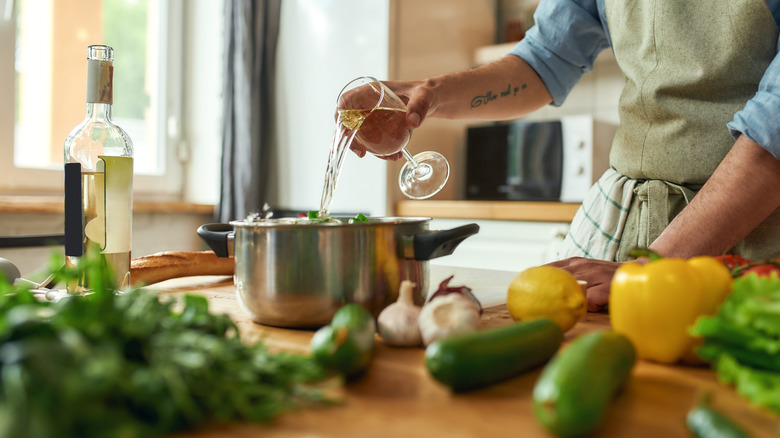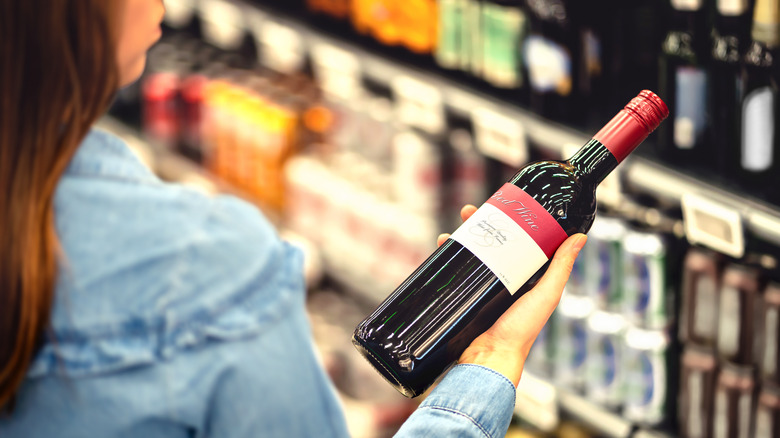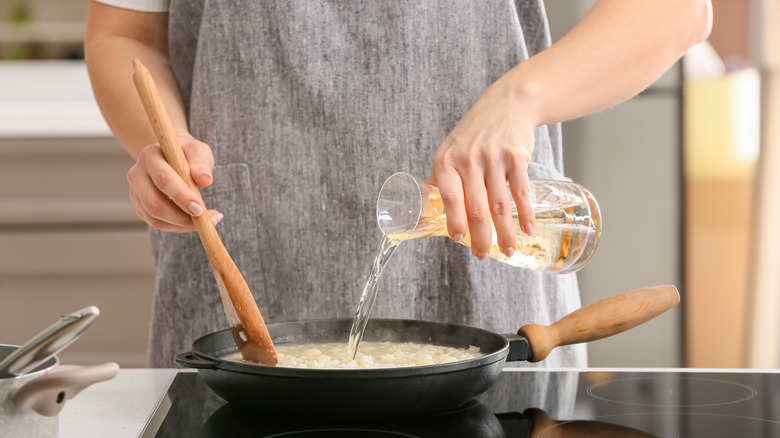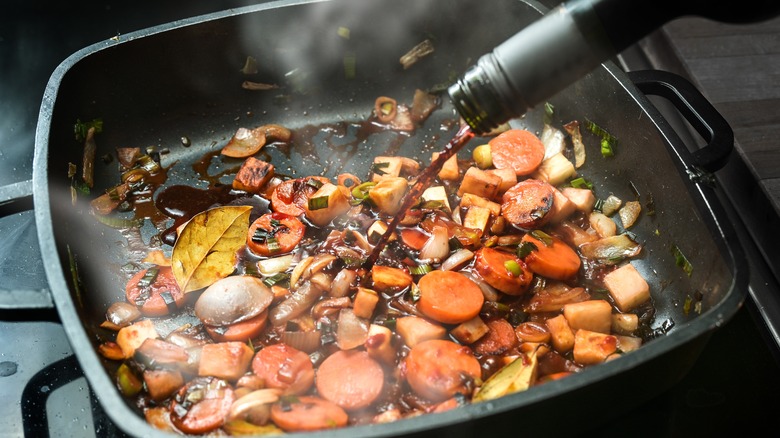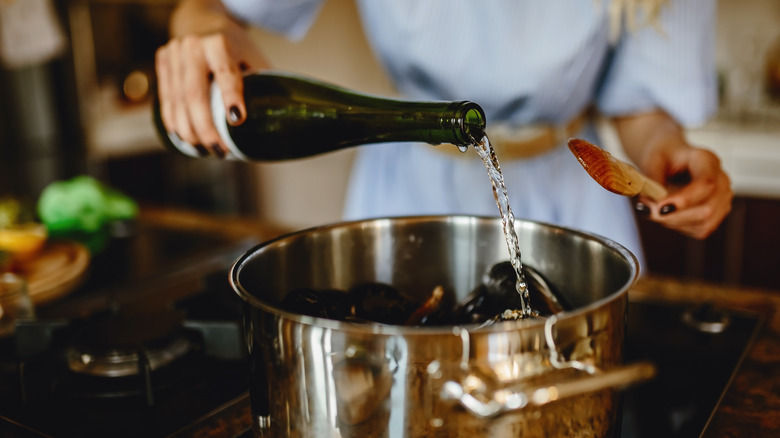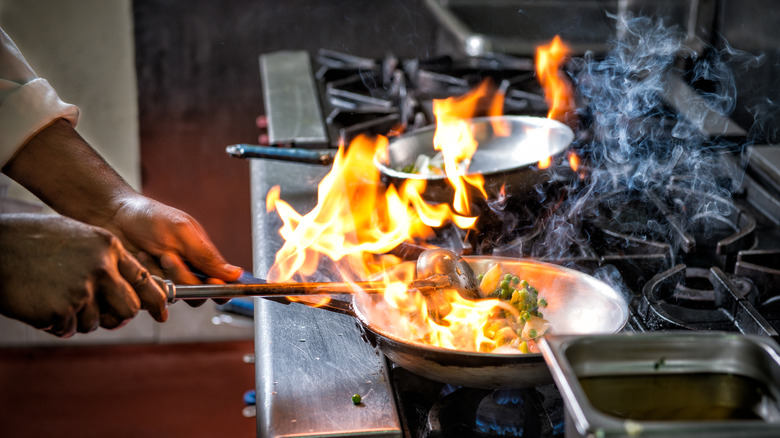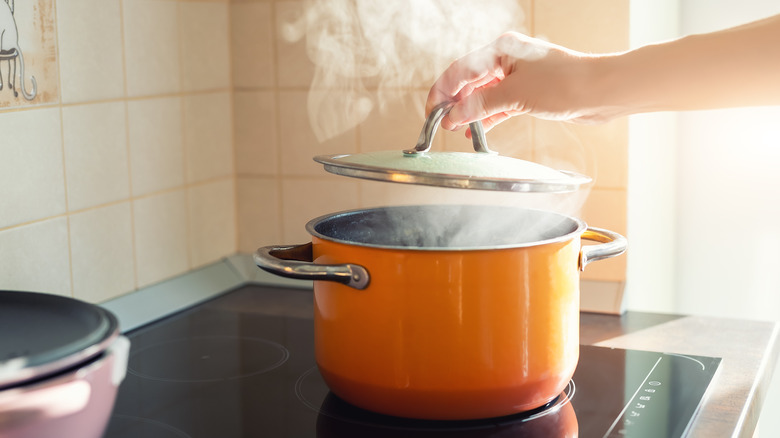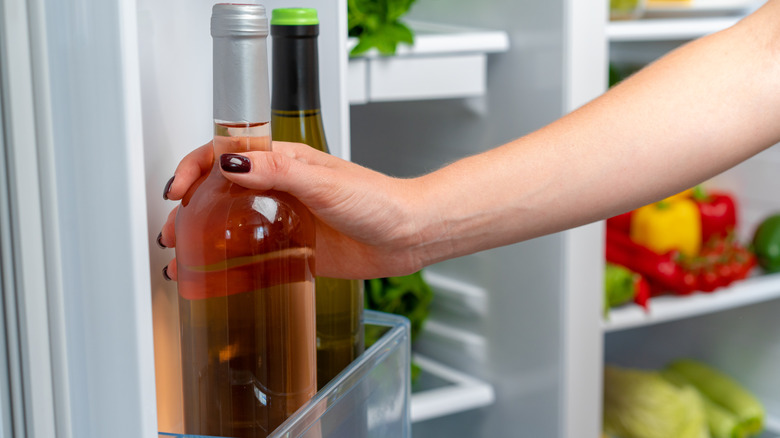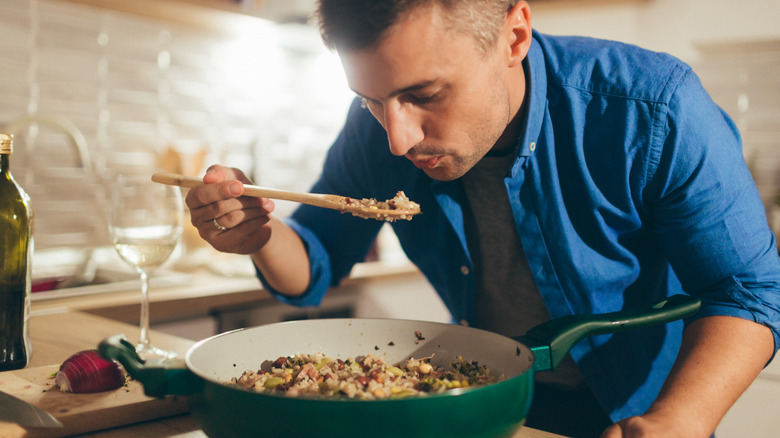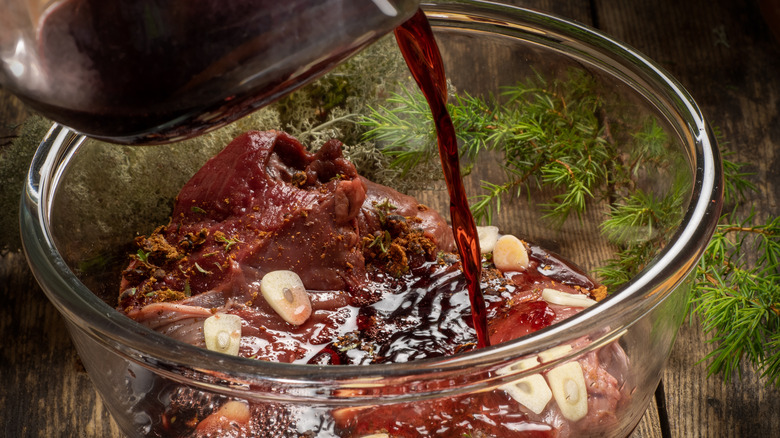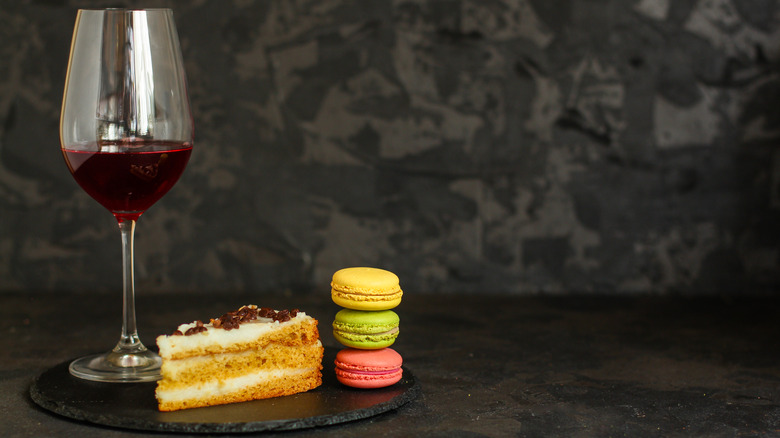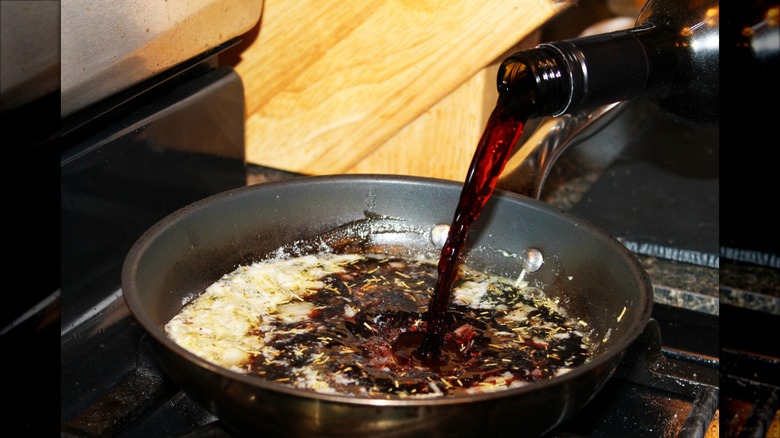12 Mistakes You Might Be Making When Cooking With Wine
You're readying yourself to make a delicious recipe at home, and you see it calls for wine. Two options: Brave it, or run away to an easier meal. We've all been there. Unless you're a seasoned chef, cooking with wine can be daunting. What kind do you use? How long does it need to cook? Will my family get drunk if they eat this? While incorporating wine into a dish isn't always a simple feat, it doesn't have to be your downfall, either.
In fact, many of the mistakes made when cooking with wine are common and easily avoidable. It could be that you're buying wine that is unnecessarily expensive, or that you opted for a sweet wine when the recipe called for a dry white and found out too late that, indeed, the recipe was right. We're here to help, if only because we too have made our own fair share of mistakes when cooking with wine, but we know how delectable the outcome can be if it's done right. Here, we'll explore some of the typical blunders made when adding wine to dishes so that the next time you face a recipe that involves chardonnay, you don't have to run away.
1. Avoiding inexpensive wine
When it comes to cooking with wine, the primary purpose is to add flavor, acidity, and complexity. While using the absolute cheapest wine might not be ideal, there's little need to reach for the highest-priced bottle. Many of the subtle nuances and intricacies found in an expensive wine can be lost in the cooking process, making it difficult to distinguish between a high-end and a reasonably priced wine. In a test conducted by Serious Eats, multiple kinds of red wine were used to prepare the Burgundian dish coq au vin. After trying a cooking "wine product," a light red, an oaky red, a boxed red blend, and an opened, spoiled red wine, only the "wine product" had unappetizing results. All of the other types had infinitesimal differences among them when used to braise the chicken.
This is not to say that wine quality is entirely irrelevant when cooking. It is still essential to choose a wine that you enjoy the taste of, as its flavors will influence the dish. However, you don't need to splurge on an expensive bottle when a cheaper option will do just fine. You may be shaking your head at the idea of buying boxed wine for your fancy French dinner, but boxed wine can be a practical choice for cooking. It typically has a longer shelf life since the vacuum-sealed bag inside prevents oxidation, which means you can use a small amount of wine for cooking without worrying about the rest going bad quickly.
2. Rushing the reduction process
When making any kind of sauce, it's a good idea to reduce it in order to maximize the flavors. Sauces that include wine are no exception. However, if this process is rushed or carried out at too high a temperature, it can lead to a loss of flavors and complexity. Even though reducing a sauce requires both time and attention, it's still relatively simple. In short, reduction involves simmering the wine to evaporate its water and alcohol content, leaving behind a thicker, more flavorful liquid. To preserve the wine's intricacies, it is essential to reduce it slowly, maintaining a steady, low heat throughout the process and tasting as you go to achieve the desired intensity.
Moreover, it can be difficult to reduce your sauce and your wine at the same time — once the alcohol has been eliminated, a significant portion of the water content will have also evaporated, leaving little sauce behind. For maximum flavor, reduce red wine before cooking with it. A more efficient approach to reducing the overall alcohol content without losing too much of the sauce itself is to work on the wine reduction separately and then dilute it with the rest of your sauce. Just as you would with any reduction, first create the base of your sauce and allow it to simmer and release the water through the steam, then do the same with your wine before combining the two.
3. Neglecting to deglaze
Deglazing is an advantageous culinary technique used to enhance the flavor of dishes. Whenever you prepare sauces, braises, gravies, or other liquid-based recipes, this method should be a go-to. By forgoing this process, you potentially lose incredible flavor, especially when cooking with wine. This is because wine already provides a sauce with dimension, and deglazing adds to that intense flavor profile. Think of making a homemade country gravy, and how it typically calls for the "drippings" to offset the blandness of just the flour mixture. Incorporating those drippings is a necessity, and it's a good way to understand why deglazing is also important for the intensity of flavor.
The technique is fairly simple: After searing or sautéing food in a pan, all the browned bits stuck to the bottom are called "fond," or "sucs" in French culinary terminology. By adding liquid such as wine to the pan and heating it, then scraping it with a gentle utensil, the fond is lifted and dissolved, infusing the liquid with rich flavors. This liquid becomes the foundation (see: "fond") for sauces or gravies, elevating the taste of your dish while reducing waste by using all the caramelized goodness left behind in the pan.
4. Adding the wine too late
The timing of wine's addition to a dish can significantly influence the flavor profile. In general, it's best to add wine early in the cooking process. By doing so, it has ample time to simmer and reduce, allowing the flavors to intermingle with the other ingredients. If wine is added too late, it could produce a harsh and overpowering flavor, largely because there isn't adequate time to cook off the alcohol and develop the flavors of the wine. What's Cooking America recommends allowing the wine to cook for at least 10 minutes and then performing a taste test before deciding if you should add more.
Some recipes may call for finishing a dish with wine, such as adding a red wine reduction to cooking pasta near the end, as executive chef Lorenzo Boni shared with Insider. Still, this is not the same as incorporating wine too late. In Boni's case, the wine is meant to reduce before being added to the pasta, so the flavor gains the rich complexity of the red wine without the harshness of alcohol.
5. Botching the flambé
Flambéing is for more than the dramatics — this culinary technique of briefly igniting alcohol to create a burst of flames also enhances the flavor in a dish. However, not all types of alcohol are suitable for flambéing. In particular, wine is not ideal because of its lower alcohol content. Learning how to easily (and safely) flambé requires you to choose the correct kind of alcohol. For the technique to work, you'll want to use alcohol that is at least 80 proof and no higher than 120 proof for the best, and safest, results (via What's Cooking America). Seeing as how most wine has under 20% alcohol by volume, as opposed to spirits like brandy, rum, or vodka, which typically have alcohol contents above 40%, it's not a good choice for flambéing.
Instead of attempting to flambé with wine, it is better to choose a more suitable spirit or liqueur with a higher alcohol content. Brandy is a popular choice for flambéing due to its higher proof and unique flavors. Once the flames subside, you can then add wine to the dish. However, it is crucial to let the wine cook for a longer duration after adding it to the pan so its flavors concentrate while reducing.
6. Not allowing the alcohol to cook down
First, it's important to know that not all traces of alcohol will cook out of a dish when cooking with spirits. But in order to let most of the alcohol evaporate, it needs to cook for an appropriate amount of time. Rest assured, what's left behind will not leave you or those eating intoxicated, so long as you let it simmer for long enough. Think of your grandma's rum cake, and how you always felt a bit of a buzz after eating a slice — Grandma probably wasn't cooking out enough of the rum.
The science is fairly simple: When the temperature of the liquid is around 172 degrees Fahrenheit, alcohol begins to evaporate; according to chef James Peterson's book "Sauces," this happens in the first 20-30 seconds of boiling. Yet after 15 minutes of reducing, there is about 40% alcohol left in the pan. The rate of evaporation then starts to decrease, and only about 5% of the remaining alcohol cooks down for each additional 15 minutes you reduce the spirit (per Wine Enthusiast). This is why it's important to keep cooking it out for some time. Wine Enthusiast explains that after that first hour, evaporation slows down and after the second hour, it slows down even more. By the time the dish has been braising for over two and a half hours, you're looking at closer to 95% of the alcohol gone.
7. Throwing away open wine too soon
Before you throw out that wine you opened two weeks ago, consider using it for cooking. It'll work just fine. While wine is susceptible to oxidation, which can lead to a deterioration in flavor and quality over time, with proper storage you can prolong the usability of opened wine for cooking. You can easily save leftover wine without any fancy tools. Some of the best methods to store your wine are resealing the cork tightly and laying the bottle on its side, utilizing a vacuum-style wine saver, or transferring the wine to an airtight container before refrigeration. After only a few days, if you don't want to drink it again, you can start incorporating it into your recipes. By minimizing air intake and refrigerating your wine, you can save it for upwards of two months.
Now, while the wine may still be drinkable after two months, it will possibly have changes in taste and aroma. However, for cooking purposes, it is still perfectly acceptable. Cooking wine typically undergoes heating and simmering, which can mitigate some of the effects of oxidation and your dish won't suffer for it.
8. Using wine you wouldn't drink
You may have heard the common adage "cook with wine you would drink," and it's not wrong. If you wouldn't drink it, why would you want to taste it in your food? This particularly goes for cooking wine, as it's not meant to drink. Although it is labeled "for cooking," it doesn't usually taste very good. Trust us, and buy an actual bottle. How else is the chef (that's you!) meant to enjoy a glass with dinner, as well as in the meal itself? One of the only instances in which a poor-tasting wine would suffice for cooking is if it is poured from an already-opened bottle of wine that has just lessened in quality.
Even when choosing an inexpensive bottle, you should go for one you'd actually drink. The reason you shouldn't cheap out on wine for cooking doesn't always coincide with price, but with flavor. Of all the wines on the shelf, the cheapest options are often made with lower-quality grapes, so they might not taste the best. However, if you love the flavor of your fave $5 Aldi wine, go for it! With all the best wines you can buy from Aldi, there's no need to buy the best-tasting expensive bottle. Our point is, use the better-tasting chardonnay, whether it's from the top shelf or the bottom.
9. Not considering the flavors of your recipe
By knowing the flavor profiles of different wines, you can select the most appropriate one to enhance the flavors of your dishes. A good general rule is "if it grows together, it goes together." This concept is rooted in the idea that local wine and local dishes have evolved together over time, complementing each other in taste and texture. For instance, an Italian wine, such as Chianti or a dry Lambrusco, would be a natural fit for Italian dishes like pasta with red sauce or the perfect osso buco.
Also, it's good to consider the flavors in your recipe so you choose a wine that will lend a balanced amount of acidity, fruitiness, and so forth. Sauvignon blanc, for example, is known for its vibrant acidity and citrusy flavors, while cabernet sauvignon is full-bodied and tannic with a bite. If you're preparing a cream sauce, gravy, or chicken recipe, then a rich, dry white wine like chardonnay is a classic choice. When sautéing vegetables, a splash of a light, herbal wine like sauvignon blanc while deglazing will layer your dish with balanced acidity.
10. Forgetting to use wine as a marinade
Using wine as a marinade is often an afterthought, but it should be one of your regular techniques in the kitchen. If you're using a marinade to break down the connective tissue in your meat, acid is an essential component to get the job done. With its acidic properties, wine is perfect for this. Not only can the acidity of wine help tenderize meat, but it can also increase overall flavor when used as a marinade.
Preparing your marinade, it helps to remember this simple pairing: red wine for red meat, such as steak; and white wine for white meat, such as chicken. As Wine Folly explains, a good marinade should have four components: acid, fat, spices, and herbs. How you combine these is entirely up to you, and with endless possibilities, you have room to experiment. While certain fruit juices, like lime or pineapple, or vinegar are a common choice for the acid needed, wine is an ideal option. Moreover, if you're choosing to make your wine-marinated meat with a wine reduction, then the flavor profile automatically has more dimension.
11. Choosing a wine with a lot of tannins or sugar
If you're using tannic wine, such as petite sirah or cabernet sauvignon, for a reduction sauce, it's essential to be mindful of the potential bitterness that can be intensified while cooking. Because the flavors of wine are left behind when it's reduced, a highly tannic wine might not be the best option. While tannins do add complexity to wine, they can also taste astringent. Typically, recipes call for a dry white wine because they are well-balanced between acidic qualities and tannins with lower residual sugar.
Sugar content matters because very sweet wine can create a concentrated and almost syrupy taste or texture when reduced. It's important to remember that all wine has some sugar, but dessert wines and sweeter wines understandably have more. It's true that sugar dissolves in water, but when left to evaporate, crystallized sugar remains. You may even remember this from science experiments in your youth. This works the same way with a simmering reduction: The water will evaporate, but the sugar won't. In fact, not only will it remain, but it could end up charred and bitter, or it could caramelize. Because of this, it's best to avoid sweet wines like port, riesling, grenache, or Sauternes.
12. Incorporating too much wine
As with most cooking faux pas, once you add an ingredient, you'll have difficulty taking it away if you went overboard. If you add too much wine, for example, your dish will likely have an overpowering taste. A proper amount could be as little as a splash or considerably more, but it takes discretion. You should taste as you go, making sure to add a little at a time and letting it cook off before getting excited with the pouring. Unlike other ingredients that can be easily added or reduced during cooking, wine is more challenging to modify once it has infused with everything else.
If you do happen to make a wave rather than a splash and can't go back in time, TV personality and chef Alex Guarnaschelli has a tip for fixing a dish after you add too much wine. It depends on what other flavors are present, but if you are dealing with a savory recipe, she suggests adding a fatty component like butter or olive oil; and if it's a sweet dish, she recommends adding more fruit or sweet ingredients to counteract the flavor of the wine.
